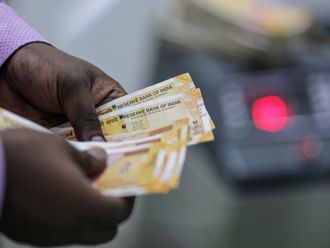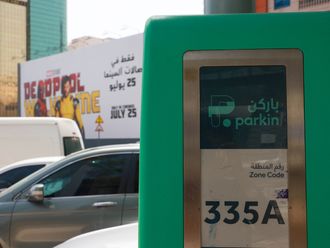
Liquidity and confidence continue to be in short supply on most of the Gulf's seven major stock markets as governments and companies implement measures designed to overcome the effects of the global economic crisis.
This may, in fact, provide investors with a good entry-point into some markets that look under-valued, analysts said.
After severely underperforming their emerging market peers in 2009, Gulf markets caught up in 2010. The S&P GCC index gained 11 per cent last year, compared to a 13 per cent rise in the MSCI EM measure. MSCI BRIC remained an underperformer with a gain of just 3 per cent.
Saudi stocks gained 8.2 per cent last year, with the index closing at 6,620.75 points. Qatar outperformed with a 25 per cent increase, Abu Dhabi was down marginally for the year while Dubai lost about 10 per cent.
"Our outlook for year 2011 is positive for most [Gulf] markets. Continued strength of oil price will certainly be a key driver for the stock markets, but that is not sufficient, as we saw in 2010. Alongside a good oil price, there are many other factors like economic performance, corporate profitability, valuation, liquidity, sentiment and geopolitics that will impact the performance of the market during 2011," M.R. Raghu, senior vice-president for research at Kuwait Financial Centre, or Markaz, told Gulf News.
Oil prices, the backbone of Gulf economies, ended 2010 on a high. Most budgets in the region have taken a conservative view on the price of crude, so liquidity at that level may not be a problem.
"At the macro [economic] level, liquidity needs to improve. Banks have to lend more to the equity investment sector for confidence to return to the stock markets," Mohammad Ali Yasin, chief investment officer at Abu Dhabi-based CAPM Investments, told Gulf News.
"If investors have confidence that they can see a capital appreciation on their investment, they will come back to the market. It's possible that liquidity will return, but I think it needs a policy push," Yasin said.
However, with most banks in the Gulf forced to provision for losses on loans to conglomerates such as Dubai World, Saad Group and Algosaibi Brothers, caution has replaced the earlier exuberance where lending is concerned.
"Most of the debt restructuring appears to be resolved now. Government and quasi-government exposures have been provisioned. Smaller surprises may crop up, but banks are well-positioned to take them in their stride," Yasin said.
Once the latest rounds of provisioning are finished, the GCC banking sector is expected to start posting profits.
Bright future
"We can expect more impressive numbers to come, especially in the second half of this year," Yasin said.
Some of the volatility experienced by GCC stocks in 2010 also made retail investors shy away from commitments.
GCC volatility, as measured by the Markaz Volatility Index, or MVX, model, has been a mixed bag in 2010. MVX GCC declined 44 per cent in the first quarter of last year before more than doubling in the second quarter followed by a decline of 62 per cent in the third.
In the same time frame, the associated index gained 12 per cent in the first quarter before losing 10 per cent in the second followed by a recovery of 11 per cent in the third quarter.
"This showcases how, as volatility begins ticking upwards, uncertainty causes investors to shy away from the market, leading to declines. Thus volatility can be a source of portfolio strategy for fund managers," Raghu said.
"One possible reason for the ultra-poor liquidity is that retail investors, which constitute the backbone of any stock market, are still busy putting their house in order while sources of traditional funding for stock market, read bank lending, have come to a complete halt," Raghu said. Earnings destruction in certain cyclical sectors like the investment sector has been too severe to stage a meaningful comeback. Even the elephant among the sectors — banking — continued to surprise investors with high levels of provisioning.
"Given firmer oil prices and a better global economic environment, the GCC is set to show stronger growth going forward despite slower private investment and credit growth continuing to be a drag on economic growth. Private demand is expected to remain weak in the intermediate term until investor confidence returns more fully and bank balance sheets return to a healthier state," Raghu said.
Tim Fox, chief economist at Emirates NBD, the UAE's largest bank by assets, also said the closure on debt restructuring efforts will add to confidence on stock markets.
"[Last month] we saw closure of two more restructuring issues in Dubai as Nakheel stated that it will repay the $750 million (Dh2.7 billion) sukuk due on January 16 and Dubai Holding announced that it has reached an agreement with three international banks to refinance a $555 million loan facility.
"All these small steps will add to the growing confidence in the local markets," Fox wrote in a note sent to Gulf News.
"Another positive for the Mena region was the oil price. Oil advanced to its highest year-end prices since 2007 as it closed at $91.38 per barrel for February delivery. This is only the second time that oil has ended the year above $90 per barrel since the contract started trading in 1983."
Strong belief
Markaz has a positive outlook for the Kuwait, Abu Dhabi, Qatar and Oman stock markets, and a neutral outlook on Bahrain, Dubai and Saudi Arabia.
Yasin, on the other hand, said: "Saudi will be for winner, in my mind."
He said oil prices provided a windfall for Saudi companies and government last year, but banks were still in introspective mode as they grappled with provisioning. When banks return to the fray this year, stock markets will feel the positive effect.
Yasin is bullish about Qatar, but does not see another 25 per cent annual gain that the market achieved in 2010 on the back of confidence generated by natural gas price gains and the Fifa World Cup 2022 success.
"There are several interesting investment themes at play," Raghu said.
"We reiterate our strong belief that high volatility should be a source of portfolio strategy rather than a problem. We believe that GCC is a good yield play."
Both Yasin and Raghu, however, believe that careful stock-picking will be the key to successful investment this year.
Dividend yield is one such aspect. With stable revenue streams, supported by buoyant economic times, GCC companies have been able to generate above-average dividend yields in recent years of between 3 and 5 per cent, with certain stocks managing yields of 8 to 13 per cent.
"Dividend yield plays can be appropriate for investors requiring a secure cash flow. Moreover, when market uncertainty results in risk aversion and a lack of capital gains, investing in high dividend yielding companies can compensate for the loss in capital gains," Raghu said.
In choosing stocks for this strategy, sector classification can also come into play; for example, some of the most consistently high-paying stocks tend to be in defensive sectors such as banks and telecoms, which "will continue to pay dividends despite market downturns", he said.
"Strategies that benefit in a low-liquidity environment are emphasised. Also, it is time to remove the wheat from the chaff through the lenses of corporate governance," Raghu said.
The economy:
According to the latest economic forecasts from the Institute of International Finance (IIF), real GDP across the GCC is likely to show a growth of 4 per cent in 2010 followed by 4.6 per cent in 2011. The International Monetary Fund has forecast similar growth rates.
These remain below the historical average for the region as credit growth and private demand remain weak in some countries. Growth in Saudi Arabia is expected to increase to 4.5 per cent in 2011 as credit growth picks up. Kuwait is expected to witness a growth of 4.4 per cent this year while Qatar will be the star with 18 per cent GDP growth.
Inflation has been relatively contained in the region while fiscal balances are tightening as countries increase spending to spur growth. However, money supply growth has been abysmal, leaving little to be channelled into equity investments. Most Gulf nations saw broad money increase at only half their five-year average.
Earnings:
Earnings weakness in 2010 pushed up price-to-earnings valuations as markets remained stagnant. Healthier corporate growth in 2011 should bring down valuations. Earnings growth is expected at 22 per cent for 2010, a number that Markaz has derived by annualising the nine-month results of Gulf companies.
"As for 2011, growth in GCC earnings is expected at 22 per cent again, which, coupled with recovering markets, would bring the P/E ration to about 12x, down from about 15x in 2010," M.R. Raghu, senior vice-president for research at Markaz, told Gulf News.
The growth in earnings is attributed to more stable economic growth in Kuwait and Saudi Arabia and a return to positive growth in Oman and the UAE.
"Regionally, we should see a subdued start to the New Year as investors await year end earnings report from companies. The earning results and management guidance will give further indications to investors about the strength and pace of economic recovery in the region," said Tim Fox, chief economist at UAE-based bank Emirates NBD.
Liquidity:
Liquidity has been drying up across the GCC markets at an accelerating rate. Total value traded declined 41 per cent in 2009 before shrinking by a further 55 per cent in 2010. With an average monthly value traded value of just $25 billion (Dh91.8 billion), the 2010 figure for the Gulf should be around $255 billion, which would be half that of 2009.
Less positive
While analysts see stock markets a little more bullish this year compared to 2010, their expectations from the initial public offering (IPO) segment are a little less positive.
Saudi Arabia-based National Commercial Bank research shows that Gulf IPOs in the first nine months of 2010 raised a total of $1.4 billion compared to $1.9 billion (Dh6.9 billion) in the same period of 2009.
Saudi Arabia was the most active IPO market, accounting for $900 million of the total raised in the first three quarters of last year.
In December, Dubai-based cellphone retailer Axiom said it had cancelled its IPO due to concerns about market conditions and liquidity.
Omani telecoms firm Nawras was forced to extend its IPO subscription period by a week to try and attract more interest.
- $1.9b: value of initial public offerings in the Gulf in the first nine months of 2009
- $1.4b: value of initial public offerings in the Gulf in the first nine months of last year
- $255b: estimated value of sharestraded on Gulf marketslast year












